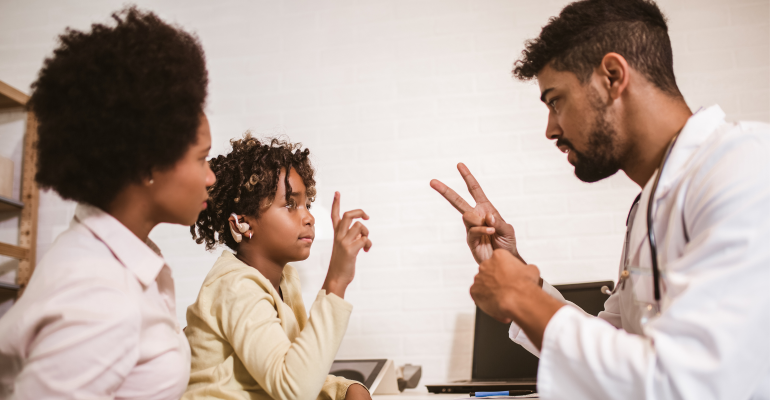In the dynamic landscape of healthcare, effective communication is pivotal to providing comprehensive and empathetic care. This is particularly crucial for deaf patients, who face unique challenges in traditional healthcare settings due to their reliance on visual cues and sign language. For these patients, expressing their symptoms, health concerns, and medical history can be a daunting task, often leading to significant disparities in healthcare access and quality. The National Technical Institute for the deaf highlights a startling reality: Deaf individuals are up to seven times more likely to suffer from heart disease, high blood pressure, and strokes compared to their hearing peers due to the disparity and knowledge gaps in preventative health for the deaf. With over 11 million people in the Middle East having hearing disabilities, the communication gap underscores the urgent need for innovative solutions in healthcare practices.
Challenges in healthcare communication
Deaf patients encounter numerous challenges in healthcare, a domain where misunderstandings can have serious consequences. Language barriers, which significantly impact deaf individuals who primarily use sign languages, impede their access to critical health information and quality healthcare. Studies reveal that deaf patients are less likely to visit their primary care providers regularly and more likely to resort to emergency services due to communication barriers. This lack of effective communication in their native language often leads to lower health literacy and knowledge among deaf individuals, even those who are well-educated.
Related: Personalised, next-gen healthcare experiences are within grasp
A significant obstacle is the scarcity of qualified sign language interpreters in healthcare settings. Many healthcare professionals lack proficiency, and interpreter services are not always available, leading to frustration and misunderstandings. Furthermore, deaf patients often confront inaccessible communication systems in healthcare facilities, such as audio or phone-based methods, which are ineffective for them. Healthcare providers can bridge this gap by partnering with companies that provide interpreter services or by learning basic sign language skills. However, beyond the linguistic barriers, there is also a need for heightened deaf awareness among healthcare professionals, who may not be familiar with the unique needs and experiences of deaf patients, leading to discrimination. Understanding this is crucial to transforming healthcare into an inclusive and effective system for all.
Healthcare providers can adopt various strategies, ranging from altering their communication methods to incorporating assistive technologies, to create a more inclusive environment for deaf patients.
The impact of sign language
Today, over 70 million deaf people use sign language globally. Beyond being a form of language, it has become a lifeline, facilitating clear and direct communication between healthcare professionals and deaf patients. Given that a mere 30-40% of speech can be lip-read even under the best conditions, training in sign language and deaf awareness becomes increasingly vital. Such education, including the use of technology, significantly enhances health outcomes, demonstrating its profound impact on improving care for the deaf community.
Technological solutions
Organisations that pioneer solutions for deaf patients are at the forefront, creating innovative digital solutions that facilitate sign-language communication in hospitals. These advancements enable real-time communication, ensuring deaf individuals have equal access to healthcare services. Hospitals can employ video conferencing and other digital tools, often incorporating information in the form of videos with live captions and remote sign language interpreters, to interact effectively with deaf patients. On-demand sign language interpreters, available 24/7, ensure effective communication and immediate resolution of any issues. These technological interventions redefine access to information, providing crucial healthcare details in a format that is understandable, thereby ensuring deaf patients are well-informed and can navigate healthcare settings with ease. This shift towards technology-enhanced inclusivity is a pivotal step in breaking down barriers and fostering a more accessible and responsive healthcare environment.
Related: Smart homes to care for the world’s ageing population
Patient-centred approach
Incorporating sign language and visual aids such as infographics significantly enriches patient-centred care for deaf individuals. By understanding and respecting deaf culture and allowing extra time for deaf patients to express their symptoms completely, healthcare providers can create a more inclusive environment. This sensitivity fosters deeper trust and satisfaction, ultimately transforming the healthcare experience for the deaf community.
To foster effective communication, healthcare facilities should offer their staff basic sign language training. Hospitals can host regular workshops, collaborate with deaf community leaders for immersive sessions, and integrate deaf culture education into their training programmes. These initiatives will not only raise awareness but also cultivate a more inclusive and compassionate approach to patient care.
The role of sign language in healthcare is a catalyst for change, fostering inclusivity and redefining patient care. By addressing communication challenges, embracing technological solutions, and prioritising inclusivity, the healthcare industry can take significant strides toward providing equitable and accessible services for all, irrespective of their hearing abilities. As we navigate the future, we must continue to champion initiatives that promote a healthcare landscape where every patient’s voice is heard.
Vitalii Potapchuk is the co-founder of Amsaan Project.






